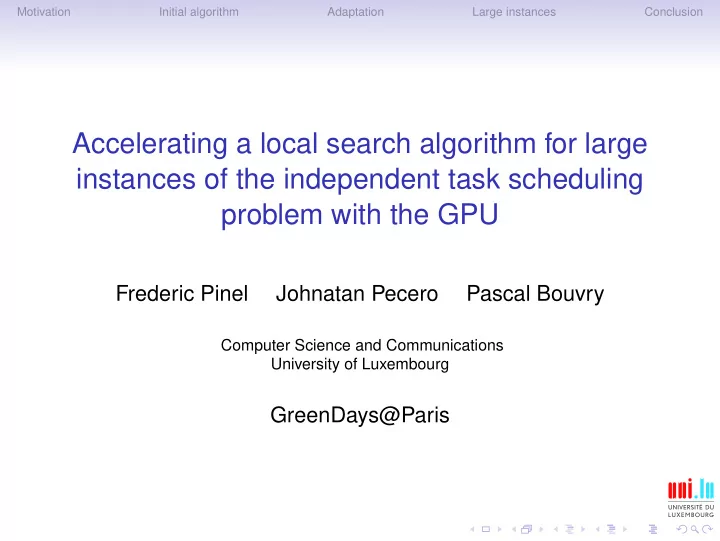

Motivation Initial algorithm Adaptation Large instances Conclusion Accelerating a local search algorithm for large instances of the independent task scheduling problem with the GPU Frederic Pinel Johnatan Pecero Pascal Bouvry Computer Science and Communications University of Luxembourg GreenDays@Paris
Motivation Initial algorithm Adaptation Large instances Conclusion Outline Motivation Initial algorithm Adaptation Large instances Conclusion
Motivation Initial algorithm Adaptation Large instances Conclusion Motivation • Independent tasks • Makespan, combines several perspectives: • User: flowtime • Provider: load balance, energy (low machine heterogeneity)
Motivation Initial algorithm Adaptation Large instances Conclusion Parallel CGA Selection Recombination Mutation Replacement Figure: Generating solution
Motivation Initial algorithm Adaptation Large instances Conclusion Parallel CGA • Parallel asynchronous cellular genetic algorithm • Initialized with heuristic (Min-Min) • Local search
Motivation Initial algorithm Adaptation Large instances Conclusion Feedback 1.0 main effect interactions 0.8 0.6 0.4 0.2 0.0 Pop P_mutation Iter_mutation P_crossover P_search Iter_search Load_search Threads
Motivation Initial algorithm Adaptation Large instances Conclusion Adaptation • Simplified algorithm • Min-Min, incremental formulation • Increased local search, complete-state formulation
Motivation Initial algorithm Adaptation Large instances Conclusion Results 1300 1200 1100 1000 900 800 700 Min-Min 2PH PA-CGA-1 PA-CGA-2 PA C GA-3 PA C GA-4 PA C GA-5 Figure: Consistent, high-h. tasks, low-h. machines
Motivation Initial algorithm Adaptation Large instances Conclusion Results 1150 1100 1050 1000 950 900 850 800 750 700 650 Min-Min 2PH PA-CGA-1 PA-CGA-2 PA-CGA-3 PA-CGA-4 PA-CGA-5 Figure: Semi-consistent, high-h. tasks, low-h. machines
Motivation Initial algorithm Adaptation Large instances Conclusion Results 860 850 840 830 820 810 800 790 780 770 760 Min-Min 2PH PA-CGA-1 PA-CGA-2 PA-CGA-3 PA-CGA-4 PA-CGA-5 Figure: Consistent, low-h. tasks, low-h. machines
Motivation Initial algorithm Adaptation Large instances Conclusion Results 770 760 750 740 730 720 710 700 690 Min-Min 2PH PA-CGA-1 PA-CGA-2 PA-CGA-3 PA-CGA-4 PA-CGA-5 Figure: Semi-consistent, low-h. tasks, low-h. machines
Motivation Initial algorithm Adaptation Large instances Conclusion Min-Min on GPU Figure: Parallel reduction in Min-Min
Motivation Initial algorithm Adaptation Large instances Conclusion Min-Min runtime 1e+06 CPU 1 thread CPU 4 threads CPU 8 threads GPU 100000 10000 Runtime (sec) 1000 100 10 1 4096x128 8192x256 16384x512 32768x1024 65536x2048 Instance size Figure: Runtime Min-Min
Motivation Initial algorithm Adaptation Large instances Conclusion Performance 2050 32 320 3200 2000 CGA 1950 1900 Makespan 1850 1800 1750 1700 1650 512x16 4096x128 8192x256 16384x512 32768x1024 65536x2048 Instance size Figure: Makespan
Motivation Initial algorithm Adaptation Large instances Conclusion Performance 600 32 320 3200 CGA - Kgen 500 400 Runtime (sec) 300 200 100 0 512x16 4096x128 8192x256 16384x512 32768x1024 65536x2048 Instance size Figure: Runtime
Motivation Initial algorithm Adaptation Large instances Conclusion Conclusion • Failure • Solution → Feedback → loop • Learning process
Motivation Initial algorithm Adaptation Large instances Conclusion Machine learning opportunities • Learn on problem instance • Task profiling • Co-scheduling • Learn allocation rules • Adapt (parameters, heuristics) • Algorithm (oracle: solved instances)
Motivation Initial algorithm Adaptation Large instances Conclusion Questions Thank you.
Recommend
More recommend